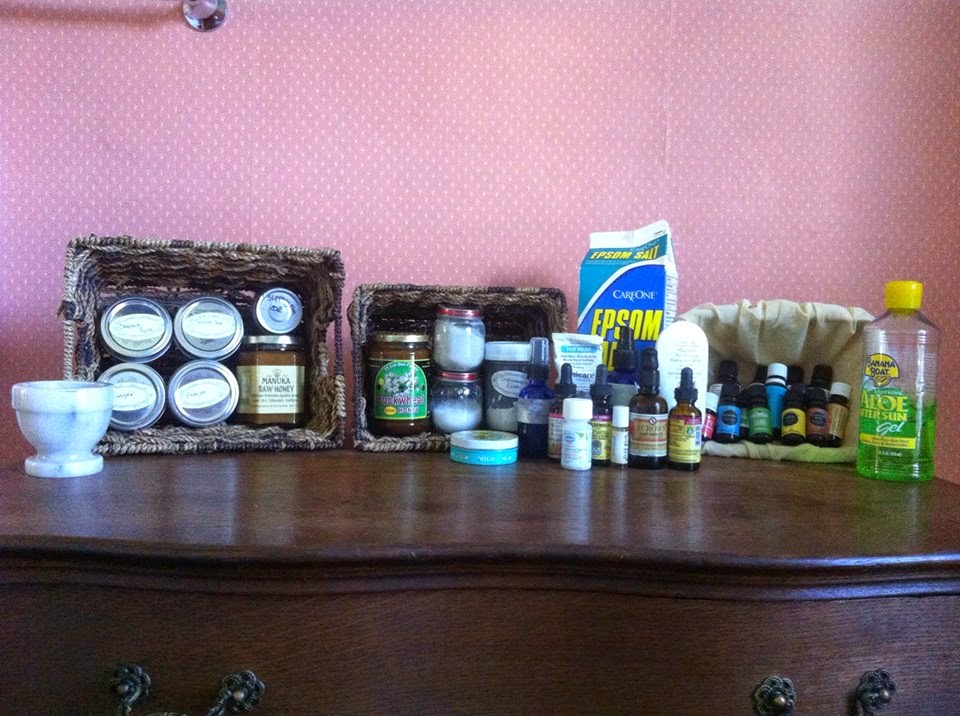While I haven't found the perfect pretty chest to store these in, here is a quick run down of just what I keep in our washroom. This list won't include things like cinnamon, turmeric, ginger, garlic, various berries etc that live in our kitchen cupboards.
Here is the run down of what and why.
Manuka Honey - it's antibacterial properties are great for injuries, and it can be taken for viral infections as well. Dr. Bob Sears just had a great write up on Facebook about why he uses it in his office to combat MRSA and other nasty infections.
Buckwheat Honey - an alternative to main stream cough syrups, this is our go-to for colds and coughs. It's also anti-inflammatory.
Diatomaceous Earth - we use this as a detox when the boys eat something yucky. It is also on hand for tooth powder, and to be sprinkled as an ant repellant.
Bentonite Clay - another cleanser and tooth powder ingredient. This one we use both externally and internally. We put it in their bath, and on their teeth as part of their tooth health routine. It also can be used to absorb yuckiness if they eat something that doesn't agree with them or poisonous. In addition it helps balance the body's PH levels.
*Activated Charcoal - our last in the line of stomach cleansers, this also is used for brightening our smiles.
Shepherds Purse - used for internal bleeding as a tea, or external injuries as a poultice.
Slippery Elm Bark - used as a tea for sore throats, coughs, intestinal complaints of both varieties, externally for burns. ***do not take if pregnant, can cause abortions***
Magnesium Oil - for balancing the body's magnesium level. Helps relieve cramping quickly, and I need to use it several times a day during my last trimester of pregnancy to help relieve prodromal labor. Magnesium is best absorbed through the skin, rather than taken internally. We spray a little on the bottom of the feet before bed. I make our own using magnesium flakes or Epsom salt.
Epsom Salts - A base for my magnesium oil, I also add this to my water daily when pregnant. Other than that we mostly add it to baths to relieve intestinal complaints, sore muscles, and to help the boys relax during baths.
Iodine - another detox solution, it also helps balance the body's PH levels and is in our tooth decay prevention regiment.
Astragulus - immune booster/cold fighter
Xylitol - cavity prevention. The molecular structure of this birch-based sweetener makes the mouth inhospitable to the bacteria that cause cavities.
Arnica - pain relief. We use both internally and externally.
Licorice Root - The boys are free to chew pieces of this whenever they want. I use it as part of a healthy syrup to top off Saturday morning pancakes. There are lots of healing attributes for this root but the ones we use it for mainly are as part of our tooth decay prevention routine, for colds and flu, heartburn, and other stomach complaints.
Juniper Berries - mainly for congestion, but also for injuries and inflammation.
*Elderberries - another immune booster for colds and flu season including bacterial and viral infections.
Aloe - for burns, hair tangles, and as hair gel.
Pau D'Arco - an expectorant that can also be used for candida
problems. It is also an antibacterial, antiviral, and anti-parasite
agent.
Goldenseal Root - used in teas for colds and
flu, as a wound antiseptic and on newborn's cord stumps. It can also
be used for upset stomach, intestinal complaints, and whooping cough.
Clove Oil - not an essential oil, but used in tooth paste and painful teething or tooth complaints.
The next three are the store bought items we have. Rather than talk about what I use them for I've put their links in.
Badger Baby Balm - http://www.badgerbalm.com/p-398-baby-balm-organic-baby-skin-care.aspx
Cape Cod Bug Repellant Lotion -http://www.capecodallnatural.com/products.html
Hyland's Teething Pellets -http://www.hylands.com/products/hylands-baby-teething-tablets
The rest are essential oils. I don't support any specific brand, nor am I an oil expert. These are what we have collected so far, and our particular uses for them. There are plenty of 'experts' when it comes to oils. For specifics, please ask them not me. I am much more comfortable and versed in the use of herbs.
Calm Time Spray - My own blend of essential oils that we use during extended tantrums and before bed when needed.
Tea Tree Oil - one of our go-tos. We use this for viral and bacterial infections.
Cinnamon Bark - Mainly used in our toothpaste.
Citronella - Mainly used in our bug spray.
Lemon - Used in our bug spray and in deodorants.
Citronella - Used in our bug spray and in deodorants.
Lavender - Used for bug bites, in baths, for headaches, and in boiling water to keep the house calm.
Eucalyptus - Used in bug spray and in deodorants.
Rosemary - Used in bug spray and in deodorants.
Thyme - Used in deodorants and topically on cysts.
Peppermint - Used in toothpaste, bug spray, and as a room cleanser.
Basil - Used topically on cysts.
Sandalwood - Used in deodorant.
* items are not shown in the photo.
I highly recommend that before you use any herb or essential oil that you do your own research as I am not any type of trained professional and am sharing what I use these items for, and am not prescribing or diagnosing anything.





















